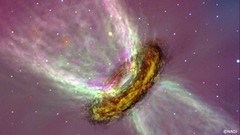Podcaster: Avivah Yamani
Title: Space Scoop: Solving the Mystery of Massive Star Birth
Organization: Astrosphere New Media
Link : astrosphere.org ; http://unawe.org/kids/unawe1414/
Description: Space scoop, news for children. How many objects are there in our Solar System?
Bio: Avivah Yamani is a Project manager of 365 Days Of Astronomy
Today’s sponsor: This episode of “365 Days of Astronomy” is sponsored by — no one. We still need sponsors for many days in 2014, so please consider sponsoring a day or two. Just click on the “Donate” button on the lower left side of this webpage, or contact us at signup@365daysofastronomy.org.
Transcript:
This is 365 Days of Astronomy. Today we bring you a new episode in our Space Scoop Series. This show is produced in collaboration with Universe Awareness, a program that strives to inspire every child with our wonderful cosmos.
Today’s story: Solving the Mystery of Massive Star Birth

With the help of some of the World’s most powerful telescopes, Japanese scientists have peered into a large gas cloud in our galaxy, to look at massive young stars. This artist’s impression shows a giant, baby star they spotted with a dusty disc around it’s middle. Credit: NAOJ
Like people, stars are born, they grow old and they die. Small and medium-sized stars, are born in enormous clouds of cold gas and cosmic dust known as nebulae.
Occasionally, something will disturb the gas in these clouds. For example, the pull of a passing star’s gravity or the violent explosion of a nearby dying star. The movement can trigger the collapse of the cloud, which begins to shrink under the pull of its own gravity.
As the cloud gets smaller, it gets clumpy. The clumps may eventually become so compact that they begin to heat up, growing hotter and hotter, until eventually they begin “burning” at their core. When the temperature at the core reaches a scorching 10 million degrees, the clump officially becomes a new star.
We know this is how small and medium-sized stars form, but what about the most massive stars? Scientists from Japan have been trying to find out.
With the help of some of the World’s most powerful telescopes, these scientists were able to peer into a large gas cloud in our galaxy that we knew contains lots of massive stars. And, lo-and-behold, they spotted something interesting — a giant, baby star with a dusty disc around it’s middle. A little like the icy rings surrounding Saturn.
When small and medium-sized stars are born any leftover gas forms a disc like this around the newborn star. It’s actually from this disc of gas and dust that planets form. So, the dusty disc spotted by Japanese scientists suggests that the formation of massive stars is actually very similar to the way that smaller stars, like the Sun, are born.
Cool Fact
Compared to the Earth, the Sun is gigantic. It would take no less than 109 Earths to stretch across the diameter of the Sun. But the Sun is just an average-sized star. The largest known star is called VY Canis Majoris, and if it replaced the Sun at the centre of our Solar System, all planets up to Saturn would be inside it!
365 Days of Astronomy is a community podcast made possible thanks to the contributions of people like you. Please consider donating at 365DaysofAstronomy.org/Donate
End of podcast:
365 Days of Astronomy
=====================
The 365 Days of Astronomy Podcast is produced by Astrosphere New Media. Audio post-production by Richard Drumm. Bandwidth donated by libsyn.com and wizzard media. You may reproduce and distribute this audio for non-commercial purposes. Please consider supporting the podcast with a few dollars (or Euros!). Visit us on the web at 365DaysOfAstronomy.org or email us at info@365DaysOfAstronomy.org. In the new year the 365 Days of Astronomy project will be something different than before….Until then…goodbye

